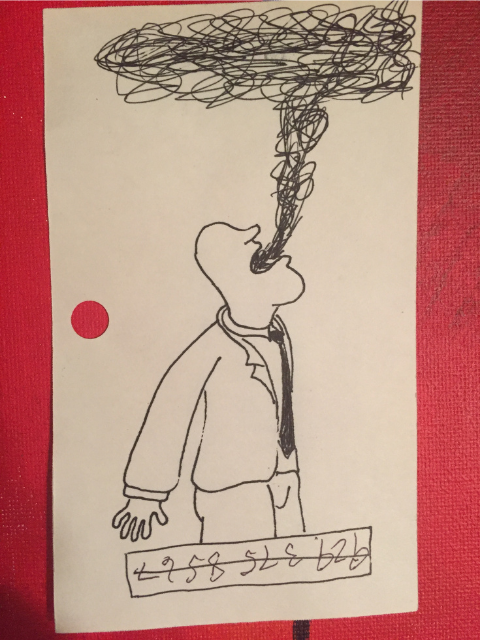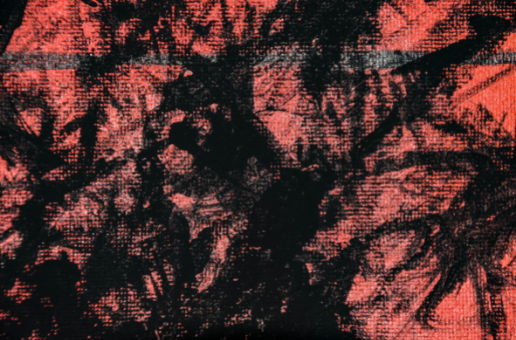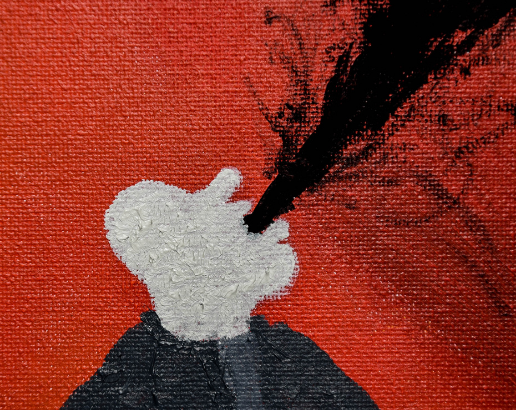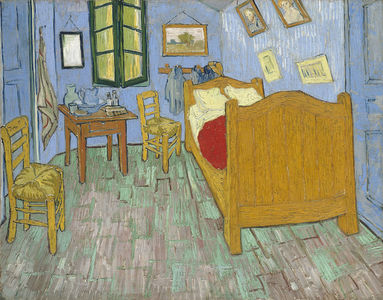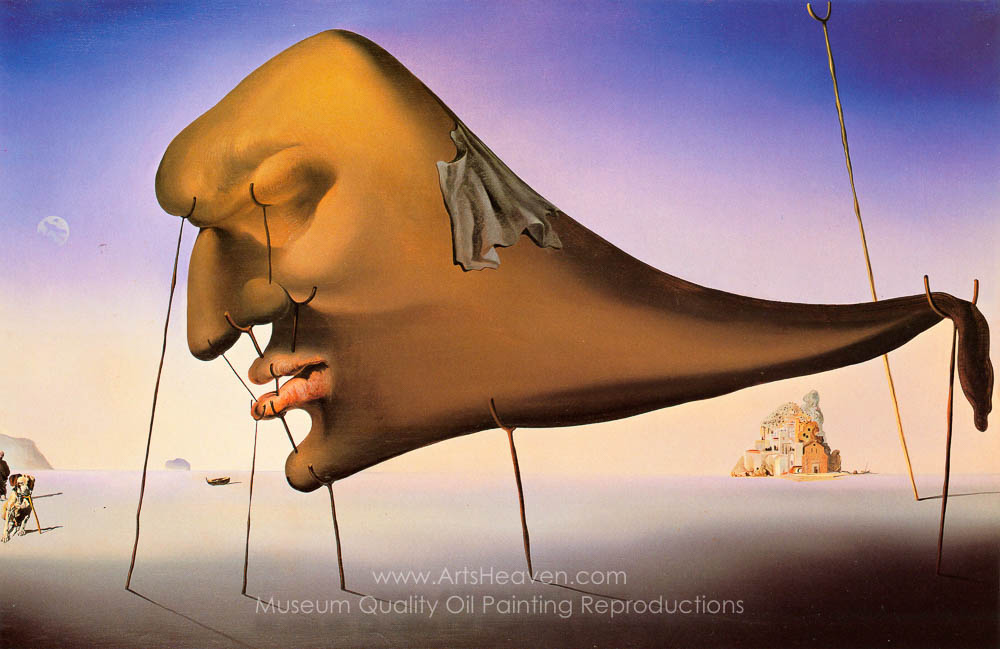The walls of Joshua “Jammer” Smith’s Tyler home are filled with his paintings. A repeated theme is figures in rooms, some spacious and others cramped.

Taking pride of place above the sofa is a 16×20 inch canvas with a scarlet and cadmium red background, “Floyd is Filled with Dreams Today.” A faceless man — Floyd — emits a cyclone of insight and energy in swirls of black. Smith explained how this particular painting stands apart from his other work.

“This painting is so unlike anything else I’ve done. Most of the time I don’t make plans for the paintings. I just wanted to get it on paper. This is one of the only times I’ve had a painting where it seemed really clear in my mind about what I was going to make,” said Smith.
“Floyd is Filled with Dreams Today” materialized while Smith was working at the Tyler Public Library. The idea came, and he hastily sketched the image on an old library card kept in his pocket.
The idea of dreams was at the center of Smith’s idea and sketch. “I use the word ‘dreams’ a lot in terms of my art and describing my art. Ultimately, my art is an attempt at what is my perception of dreams. Daydreaming really is important. So with this figure, I was so filled up with all these dreams in my head,” said Smith.
Smith chose to paint the figure in oils, but the rest of the piece is in acrylics. The red background and the black stream pouring out of Floyd are acrylic, but Smith points out that not all acrylics are the same.
“It’s really important to note the brand of acrylic is known as Black 3.0 produced by a visual artist in England named Stuart Semple,” said Smith.
Semple, who runs an organization called Culture Hustle, created this pigment because fellow British artist Anish Kapoor had licensed sole proprietary rights over Vantablack, at the time the world’s blackest black. “He and his organization basically researched and worked to create their own black, which absorbs 99% of visible light, marketed as the blackest black,” said Smith.
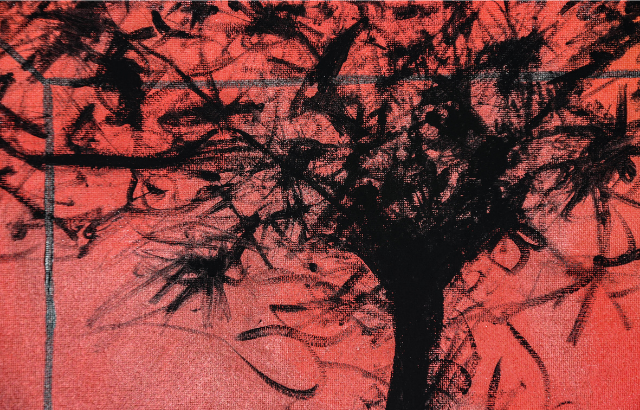
The look of Black 3.0 was a deliberate choice for Smith, who immediately fell in love with it. “I had tinkered with it a couple of previous paintings before. I was just struck dumb by this color — or really with its lack of color. I never had such a physical or even an emotional reaction to a color, but the moment I saw it on the canvas, I was just spellbound.”
Of the figure named Floyd, Smith said, “I guess he was my way of trying to capture that energy or that desire to capture those dreams. And so it just manifested perfectly in this little figure.”
“Floyd is Filled with Dreams Today” is unique to Smith because the idea materialized all at once, and also because Smith chose a title for the painting. “Most of the time, my paintings don’t have names. It would usually just be “Red Room” and then the date.
“But for whatever reason, this painting just felt different. It felt like it needed something a little more personal. Floyd is in this red room and the dreams are just coming out like smoke.
“And then as you get up into the top you’ll note little clusters. I started trying to make it look a little bit more like neurons in a brain to mimic the way that ideas and dreams can flow literally through your brain on the neurons.”
Smith said putting Floyd in a red room holds significance. “Red is the most difficult color on the visible spectrum for humans to perceive. It’s like right there at the tail end [of the spectrum] as colors begin to turn into invisible waves.
“Red seemed like the best choice [to convey] that moment you’re on the edge of what is perceivable,” said Smith.
Black, too, was an intentional color choice. “I was and still am taking a lot of influence from painters like Francis Bacon and David Lynch. They tend to use a lot of dark colors: a lot of black, a lot of deep purples and deep blues,” said Smith.
“Those darker colors help people blur those edges of what they perceive to be reality, especially with dreams. Whether it be your daydreams or the dreams you have while you’re asleep, the qualities of them can seem just so blurry and ephemeral. Black seemed like the perfect color to communicate it.”
Smith said Floyd’s neutral body allows viewers to project themselves onto the figure more easily. Noting Floyd’s lack of eyes, facial features and identifying details, Smith said, “I wanted people to be able to imprint themselves at least a little bit on Floyd. I call him Floyd, but he could be a man. He could be a woman. He could be trans. It could be anybody.”
“I don’t believe that Floyd is an extension of me per se, but I do feel he’s my way of trying to express where I was at that day and how my head was just full of dreams, and I had to get it out,” said Smith.
Smith, who holds degrees from The University of Texas at Tyler in English with specialization in rhetoric and queer theory, said art and art studies were with him growing up.
“Art was just always there. My mom taught me to read using Calvin and Hobbs comic strips. [My mom] loved art and has always appreciated art history. There were dozens of art history books around the house growing up. She just always encouraged me to draw as much as I could, and I can honestly say art was my favorite class in school,” said Smith.
There are several genres influencing and informing Smith’s style. “A little bit of cubism, definitely surrealism, expressionism, neo-expressionism and impressionism,” he said.
Smith said the works of surrealist painter Salvador Dali were a strong influence during his teenage years. Additionally, Smith is drawn to neo- expressionists like John Michel Basquiat, the impressionists and the post- impressionists. “My mom loves Vincent van Gogh. I heard a lot about the impressionists growing up,” he said.
Like the character Floyd, Smith prefers to leave the painting’s message at the viewer’s discretion. “I have trouble working with a kind of conscious message to people because I like people’s reactions more than anything else,” he said.
Nonetheless, Smith hopes his paintings evoke a specific response. “More than anything else, all of my paintings and drawings are my attempt to understand my perception of reality. And in that way they are attempts at being mindful, being present in a space and a place. It’s something I’m still constantly working on.”
Smith says he is not interested in viewers solving the puzzle of what the painting means or the story behind it. “Instead, I would really hope that you look at it and become aware of yourself in a space in relation to the art,” he said.
Smith has a singular hope for those who view his work. “Some people are going to love it. Some people are going to hate it. I can’t control what their reaction is going to be. I don’t care what your reaction is, but please feel something.”
Love what you're seeing in our posts? Help power our local, nonprofit journalism platform — from in-depth reads, to freelance training, to COVID Stories videos, to intimate portraits of East Texans through storytelling.
Our readers have told us they want to better understand this place we all call home, from Tyler's north-south divide to our city's changing demographics. What systemic issues need attention? What are are greatest concerns and hopes? What matters most to Tylerites and East Texans?
Help us create more informed, more connected, more engaged Tyler. Help us continue providing no paywall, free access posts. Become a member today. Your $15/month contribution drives our work.


